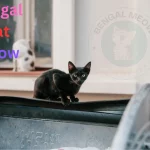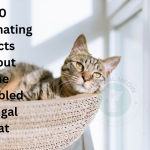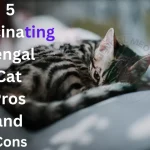Biggest Bengal Cat: Unveiling the Majestic Giant of the Breed
The biggest Bengal cats can weigh up to 22 pounds. They are muscular and agile with a wild appearance.
Bengal cats are a captivating breed known for their striking appearance and energetic nature. Originating from the hybridization of domestic cats and Asian leopard cats, these felines boast a distinctive coat with rosettes, spots, or marbling patterns. Their playful and active demeanor makes them a popular choice among cat enthusiasts.
Bengals are intelligent and require mental stimulation to stay happy. Regular interaction and plenty of toys are essential for their well-being. They also form strong bonds with their owners, making them affectionate pets. With proper care, Bengal cats can thrive in a domestic setting, providing endless entertainment and companionship.
Introduction To Bengal Cats
Bengal cats are one of the most striking cat breeds. They are known for their wild appearance and friendly nature. These cats are playful and full of energy.
Breed History
The Bengal cat breed has an interesting history. It began in the 1960s. A leopard cat was bred with a domestic cat. This created the first Bengal cat. The breed was officially recognized in the 1980s. Since then, they have become very popular.
Physical Characteristics
Bengal cats have unique physical traits. They have a muscular build and sleek coats. Their fur is short and dense. It often has spots or marbled patterns. These patterns resemble wild cats like leopards.
| Feature | Description |
|---|---|
| Size | Medium to large, up to 15 pounds |
| Coat | Short, dense, and soft |
| Patterns | Spotted or marbled |
| Color | Brown, silver, snow, charcoal |
Their eyes are large and oval-shaped. They can be green, gold, or blue. Bengal cats have a graceful, athletic appearance. Their tails are thick and tapered.
The Majestic Giant
The Bengal cat is a breed that captures attention. Among them, some stand out due to their size. These are often referred to as the Biggest Bengal Cats. Their size, coupled with their striking appearance, makes them truly majestic. This section delves into the unique characteristics of these giant Bengals.
Defining The Biggest Bengal
Not all Bengal cats grow to be giants. The Biggest Bengals have a distinct size that sets them apart. These cats can weigh between 15 and 22 pounds. They can also reach a length of up to 22 inches, not including the tail.
| Characteristic | Measurement |
|---|---|
| Weight | 15-22 pounds |
| Length (excluding tail) | Up to 22 inches |
Unique Traits
The biggest Bengal cats have unique traits. These traits make them stand out. Here are some notable features:
- Muscular Build: They have a strong and muscular build.
- Spotted Coat: Their coat features striking spots or rosettes.
- Active Nature: These cats are highly active and love to play.
- Vocal: They are known to be quite vocal and communicative.
These traits make the biggest Bengals both beautiful and unique. Their size and personality captivate everyone. Owning one is truly a special experience.
Growth And Development
Bengal cats are known for their wild looks and playful nature. Understanding their growth and development can help you care for them better. Let’s explore the factors influencing their size and the different growth stages they go through.
Factors Influencing Size
Several elements contribute to the size of a Bengal cat. These include genetics, diet, and exercise.
- Genetics: The lineage of the Bengal cat plays a crucial role. Cats from larger ancestors tend to grow bigger.
- Diet: A balanced diet ensures proper growth. High-quality food with necessary nutrients is essential.
- Exercise: Regular physical activity helps in muscle development. Active cats are usually healthier and stronger.
Growth Stages
Bengal cats go through various growth stages. Each stage has unique characteristics.
- Kitten Stage (0-6 months): Rapid growth occurs during this period. They need a lot of nutrients.
- Adolescent Stage (6-18 months): Growth slows down. They start to develop more muscle mass.
- Adult Stage (18 months+): They reach their full size. Maintenance of diet and exercise is crucial.
Understanding these stages helps in providing the best care for your Bengal cat. Proper nutrition and exercise are key to their healthy growth.
Diet And Nutrition
Bengal cats are known for their striking appearance and playful nature. Their diet and nutrition are critical for maintaining their health and energy levels. An optimal diet ensures they receive all the essential nutrients they need for growth and activity.
Essential Nutrients
Bengal cats need a balanced diet rich in proteins, fats, and essential vitamins. Proteins are crucial for muscle growth and overall health. Animal-based proteins, like chicken and fish, are ideal. Fats provide energy and support skin and coat health. Omega-3 and Omega-6 fatty acids are particularly beneficial. Vitamins such as A, B, D, E, and K play vital roles in their bodily functions.
| Essential Nutrient | Role | Sources |
|---|---|---|
| Proteins | Muscle growth and repair | Chicken, Fish, Turkey |
| Fats | Energy and skin health | Fish oil, Chicken fat |
| Vitamins | Various bodily functions | Organ meats, Fish |
Feeding Tips
Follow these tips to ensure your Bengal cat gets the best nutrition:
- Feed high-quality commercial cat food.
- Ensure the food is rich in animal-based proteins.
- Provide fresh water at all times.
- Avoid feeding your cat human food.
- Monitor portion sizes to prevent obesity.
Feeding your Bengal cat the right diet ensures they stay healthy and active. Always consult your veterinarian for personalized feeding advice.
Health And Wellness
The health and wellness of your Bengal Cat are crucial. A healthy cat is a happy cat. Ensuring their well-being involves regular vet visits, a balanced diet, and lots of love.
Common Health Issues
Bengal Cats can face various health issues. Some of the most common are:
- Hypertrophic Cardiomyopathy (HCM): A heart condition that thickens the heart muscles.
- Progressive Retinal Atrophy (PRA): This affects the retina and can lead to blindness.
- Patellar Luxation: Kneecap dislocation that affects mobility.
| Health Issue | Description | Symptoms |
|---|---|---|
| HCM | Heart muscle thickening | Breathing trouble, lethargy |
| PRA | Retina degeneration | Night blindness, dilated pupils |
| Patellar Luxation | Kneecap dislocation | Limping, leg favoring |
Preventative Care
Preventative care helps keep your Bengal Cat healthy. Here are some tips:
- Regular Vet Checkups: Visit the vet twice a year.
- Balanced Diet: Feed high-quality, protein-rich food.
- Exercise: Provide toys and playtime to keep them active.
- Vaccinations: Keep up with all required shots.
By following these steps, your Bengal Cat can enjoy a long, healthy life. Keep an eye on their health and act quickly if you notice any changes.
Training And Behavior
Training a Bengal cat can be rewarding. Bengal cats are intelligent and active. They need proper training to behave well. This section covers socialization techniques and behavioral challenges.
Socialization Techniques
Socializing a Bengal cat is crucial. They need to interact with people and pets. Here are some effective socialization techniques:
- Early Exposure: Introduce your Bengal cat to different environments.
- Positive Reinforcement: Use treats and praises to encourage good behavior.
- Play Sessions: Engage in interactive playtime to build trust.
- Calm Approach: Stay calm and patient during social interactions.
Behavioral Challenges
Bengal cats can have behavioral challenges. Addressing these issues early is important. Here are common challenges and solutions:
| Challenge | Solution |
|---|---|
| Scratching Furniture | Provide scratching posts and pads. |
| Excessive Meowing | Ensure they have enough playtime and attention. |
| Aggression | Use toys to redirect aggressive behavior. |
| Litter Box Issues | Keep the litter box clean and accessible. |
Bengal cats need consistent training. They thrive on routine and structure. Addressing behavioral challenges ensures a happy household.
Living With A Giant Bengal
Living with a giant Bengal cat can be an exciting adventure. These magnificent felines are known for their striking appearance and playful nature. A giant Bengal cat requires special attention and care. This section will explore what it means to share your home with one of these majestic creatures.
Home Environment
A giant Bengal cat needs a spacious home environment. They love to explore and climb. Make sure your home has tall cat trees and shelves. Bengals enjoy high places where they can observe everything. A large, sturdy scratching post is essential. Bengals have strong claws and love to scratch.
Provide plenty of interactive toys to keep them entertained. Puzzle feeders can stimulate their minds. Bengals are intelligent and need mental challenges. A safe outdoor enclosure is a great addition. It allows them to enjoy fresh air and nature safely.
Exercise Needs
Giant Bengal cats are very active and energetic. They require regular exercise to stay healthy. Daily play sessions are a must. Use feather wands, laser pointers, and balls to engage them. Bengals love to chase and pounce.
Consider setting up an agility course indoors or in your yard. This can provide excellent exercise and fun. Interactive toys that mimic hunting can keep them busy for hours. Regular exercise helps prevent obesity and keeps their muscles strong.
Living with a giant Bengal cat is a rewarding experience. These cats bring joy and excitement to any home.
Frequently Asked Questions
What Is The Size Of A Bengal Cat?
Bengal cats typically weigh between 8 to 15 pounds.
How Big Can Bengal Cats Get?
Some Bengal cats can grow up to 18 pounds.
Are Bengal Cats The Largest Domestic Cats?
No, Maine Coons are generally larger than Bengal cats.
What Factors Affect Bengal Cat Size?
Genetics and diet play a crucial role in their size.
How Fast Do Bengal Cats Grow?
Bengal cats reach full size around 1 to 2 years old.
Do Male Bengals Grow Larger Than Females?
Yes, male Bengals are usually larger than females.
Are All Bengal Cats Big?
Not all Bengal cats are large; size varies individually.
Can Bengal Cats Be Overweight?
Yes, like any cat, Bengals can become overweight without proper diet.
How To Keep Bengal Cats Fit?
Provide a balanced diet and regular exercise to maintain their fitness.
Do Bengal Cats Need Special Diet For Growth?
High-protein diets help Bengals grow healthy and strong.
Conclusion
The Bengal cat’s size and beauty captivate many pet lovers. Their wild appearance and friendly nature make them unique. Owning a Bengal cat brings joy and excitement to any home. Consider adopting one to experience their playful and affectionate personality.
These majestic cats truly stand out in the feline world.




